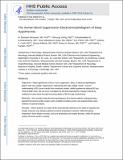| dc.contributor.author | Brandon Westover, M. | |
| dc.contributor.author | Ching, ShiNung | |
| dc.contributor.author | Kumaraswamy, Vishakhadatta M. | |
| dc.contributor.author | Akeju, Oluwaseun | |
| dc.contributor.author | Pierce, Eric | |
| dc.contributor.author | Cash, Sydney S. | |
| dc.contributor.author | Kilbride, Ronan | |
| dc.contributor.author | Brown, Emery Neal | |
| dc.contributor.author | Purdon, Patrick L. | |
| dc.date.accessioned | 2017-11-20T16:03:05Z | |
| dc.date.available | 2017-11-20T16:03:05Z | |
| dc.date.issued | 2015-01 | |
| dc.identifier.issn | 1388-2457 | |
| dc.identifier.uri | http://hdl.handle.net/1721.1/112235 | |
| dc.description.abstract | Objective: Deep hypothermia induces 'burst suppression' (BS), an electroencephalogram pattern with low-voltage 'suppressions' alternating with high-voltage 'bursts'. Current understanding of BS comes mainly from anesthesia studies, while hypothermia-induced BS has received little study. We set out to investigate the electroencephalogram changes induced by cooling the human brain through increasing depths of BS through isoelectricity. Methods: We recorded scalp electroencephalograms from eleven patients undergoing deep hypothermia during cardiac surgery with complete circulatory arrest, and analyzed these using methods of spectral analysis. Results: Within patients, the depth of BS systematically depends on the depth of hypothermia, though responses vary between patients except at temperature extremes. With decreasing temperature, burst lengths increase, and burst amplitudes and lengths decrease, while the spectral content of bursts remains constant. Conclusions: These findings support an existing theoretical model in which the common mechanism of burst suppression across diverse etiologies is the cyclical diffuse depletion of metabolic resources, and suggest the new hypothesis of local micro-network dropout to explain decreasing burst amplitudes at lower temperatures. Significance: These results pave the way for accurate noninvasive tracking of brain metabolic state during surgical procedures under deep hypothermia, and suggest new testable predictions about the network mechanisms underlying burst suppression. | en_US |
| dc.description.sponsorship | National Institutes of Health (U.S.) (Grant DP2-OD006454) | en_US |
| dc.description.sponsorship | National Institutes of Health (U.S.) (Grant DP1-OD003646) | en_US |
| dc.description.sponsorship | National Institutes of Health (U.S.) (Grant TR01-GM104948) | en_US |
| dc.publisher | Elsevier | en_US |
| dc.relation.isversionof | http://dx.doi.org/10.1016/J.CLINPH.2014.12.022 | en_US |
| dc.rights | Creative Commons Attribution-NonCommercial-NoDerivs License | en_US |
| dc.rights.uri | http://creativecommons.org/licenses/by-nc-nd/4.0/ | en_US |
| dc.source | PMC | en_US |
| dc.title | The human burst suppression electroencephalogram of deep hypothermia | en_US |
| dc.type | Article | en_US |
| dc.identifier.citation | Brandon Westover, M. et al. “The Human Burst Suppression Electroencephalogram of Deep Hypothermia.” Clinical Neurophysiology 126, 10 (October 2015): 1901–1914 © 2015 International Federation of Clinical Neurophysiology | en_US |
| dc.contributor.department | Massachusetts Institute of Technology. Department of Brain and Cognitive Sciences | en_US |
| dc.contributor.mitauthor | Brown, Emery Neal | |
| dc.contributor.mitauthor | Purdon, Patrick L. | |
| dc.relation.journal | Clinical Neurophysiology | en_US |
| dc.eprint.version | Author's final manuscript | en_US |
| dc.type.uri | http://purl.org/eprint/type/JournalArticle | en_US |
| eprint.status | http://purl.org/eprint/status/PeerReviewed | en_US |
| dc.date.updated | 2017-11-01T14:05:01Z | |
| dspace.orderedauthors | Brandon Westover, M.; Ching, ShiNung; Kumaraswamy, Vishakhadatta M.; Akeju, Oluwaseun; Pierce, Eric; Cash, Sydney S.; Kilbride, Ronan; Brown, Emery N.; Purdon, Patrick L. | en_US |
| dspace.embargo.terms | N | en_US |
| dc.identifier.orcid | https://orcid.org/0000-0003-2668-7819 | |
| dc.identifier.orcid | https://orcid.org/0000-0001-5651-5060 | |
| mit.license | PUBLISHER_CC | en_US |
| mit.metadata.status | Complete | |
